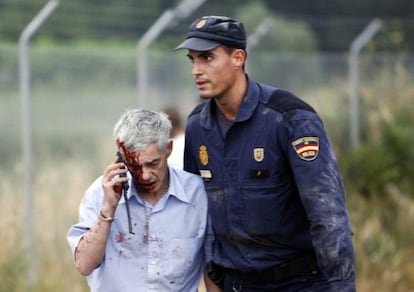“I had to go at 80km/h but I’m going at 190”
Rail firm Talgo confirms the locomotive was going at an “extreme speed” before derailing


At 8.41pm on Wednesday night, when the Alvia intercity train headed from Madrid to Ferrol was travelling at 190km/h, a warning signal went off in the driver’s compartment. It was to tell the operator, Francisco José Garzón, that he should reduce his speed to 80km/h before the train of two engines and eight carriages took a sharp curve.
The train left the tracks that had been reconfigured in 2011 to adapt them to the high-speed AVE trains and entered the older section of the route. As the train took the corner, it derailed, with tragic consequences. As of Friday morning, the death toll stands at 78 people.
After the crash, the driver used his cellphone to call the 24-hour emergency services number. “I had to go at 80km/h but I’m going at 190,” he is heard to say. In the recording, which was handed over to the judge investigating the case on Wednesday night, the driver uses the present tense, despite the fact that the accident had already taken place.
He is also heard to speak of “the poor passengers,” adding “I hope that no one has been killed…”
The Talgo rail firm, which uses internal speed controls in its trains, informally confirmed on Thursday that the train was traveling at an “extreme speed.”
In his first reconstruction of events, Garzón confirmed that an alert did go off in the driver’s compartment, and that he pressed a button to acknowledge that he had received the excessive speed warning.
But if that was the case, why did he not put on the brakes? Why would a train driver with so many years of experience take a sharp bend at a dangerous velocity?
This is what the investigation into the accident – the worst that Spain’s rail network has suffered in 40 years – will aim to clarify.
Ana, a 37-year-old survivor of the crash who regularly uses the rail route, explained that she realized just before the accident that something was wrong. “We had never left that tunnel so fast,” she said. “My carriage flipped over and turned into a mass of twisted metal.”
“The driver was going too fast,” said David Manso Fernández from his hospital bed. “He tried to brake but it was too late.”
For many families affected by the tragedy, Thursday was a day of desperate searching. The sister of Carolina Besada Garrido, an 18-year-old girl who was traveling to Santiago alone for the city’s fiestas – which have been canceled in the wake of the accident – called for help on the internet to find out whether her sister was one of the victims. Users of the social networks did what they could to help her, sending her pictures of the survivors. But on Thursday morning her death was confirmed.
The residents of Galicia have rallied around to support the victims. So many people came to donate blood at local transfusion points that the staff were unable to cope with the number of volunteers. According to information from the regional health authority, enough blood was received for 2,000 operations.
Healthcare staff who were on vacation immediately returned to their places of work to help with the treatment of the injured, while local hotels and hostels offered free accommodation to the victims of the families and taxi drivers were offering lifts without charging a euro.
Tu suscripción se está usando en otro dispositivo
¿Quieres añadir otro usuario a tu suscripción?
Si continúas leyendo en este dispositivo, no se podrá leer en el otro.
FlechaTu suscripción se está usando en otro dispositivo y solo puedes acceder a EL PAÍS desde un dispositivo a la vez.
Si quieres compartir tu cuenta, cambia tu suscripción a la modalidad Premium, así podrás añadir otro usuario. Cada uno accederá con su propia cuenta de email, lo que os permitirá personalizar vuestra experiencia en EL PAÍS.
¿Tienes una suscripción de empresa? Accede aquí para contratar más cuentas.
En el caso de no saber quién está usando tu cuenta, te recomendamos cambiar tu contraseña aquí.
Si decides continuar compartiendo tu cuenta, este mensaje se mostrará en tu dispositivo y en el de la otra persona que está usando tu cuenta de forma indefinida, afectando a tu experiencia de lectura. Puedes consultar aquí los términos y condiciones de la suscripción digital.
Últimas noticias
From digital curfews to blocking apps: How technology experts protect their children online
Why the price of coffee has skyrocketed: from Brazilian plantations to specialty coffee houses
Confined to a Cuban hospital: When electricity is a matter of life or death
The complicated life of Francesca Albanese: A rising figure in Italy but barred from every bank by Trump’s sanctions
Most viewed
- Why we lost the habit of sleeping in two segments and how that changed our sense of time
- Trump’s obsession with putting his name on everything is unprecedented in the United States
- Pablo Escobar’s hippos: A serious environmental problem, 40 years on
- The Florida Keys tourist paradise is besieged by immigration agents: ‘We’ve never seen anything like this’
- Charles Dubouloz, mountaineering star, retires at 36 with a farewell tour inspired by Walter Bonatti








































